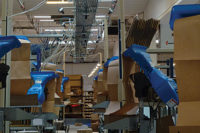
One form of integrated system blends security system functionality with building automation, the type of system that traditionally is used to control heat, ventilation and air conditioning (HVAC), power and other functionality in office and apartment buildings. One systems integrator that is strong in both security and building automation is Facility Robotics Inc. of Roswell, Ga. SDM checked in recently with Facility Robotics vice president of business development, Lionel Silverman, to get his assessment of the challenges and opportunities involved in integrating the two types of systems.
SDM: What are the advantages of integrating a building management and security system?
SILVERMAN: The benefits are huge. Customers would like to be able to connect a card reader to trigger air conditioning and lights on just a single floor or area of a building. The main reason for doing it is to save money. The idea is the user can illuminate areas that need lights after hours or run air conditioning in certain areas only.
Another benefit is that one can install one IP address to a particular remote point and pick up both security and building automation all on one controller, which is a huge cost savings.
SDM: Are you seeing a lot of interest from customers in integrating building automation and security?
SILVERMAN: A lot are talking about it, but few are doing it. The best solution is to develop tightly integrated systems but to do that, we’ve had to develop custom software, which is expensive and subject to many unknowns. The problem is that the big manufacturers in the security industry haven’t gotten involved yet. They’re not really seeing the opportunity. The automation market is ahead of the security market when it comes to interoperability. In the automation market, interoperability between various manufacturers is the norm now. Many of the products made by various manufacturers can talk to each other using LonWorks, BACnet and Modbus protocols.
We have also done some systems integration using contact closures, but the problem with contact closures is you get limited information. You get a piece of data instead of a flow of data. You’d like to get a stream of data from the access control system to tell you who and when someone went in and out.
SDM: In an integrated system, which becomes the master control – the access control system or the automation system?
SILVERMAN: Either one could become the master control. It would depend who is in the building first and who has the majority share of the operations of the building. Or if it’s a single-story building with 95 card readers, the access control system is likely to be the master control.
It also depends on the purpose of the system. If it’s a data warehouse where security and keeping everything cool is very important, it could be building automation. If it’s a regular warehouse, it could be the security system.
SDM: How is communication between systems achieved?
SILVERMAN: Eventually you’ll have an Ethernet card reader on a local Ethernet bus talking to the building automation system, and the connection from the building to the host will be Ethernet over a VPN [Virtual Private Network]. Down the road, every door could have three points of IP connectivity – an IP access control reader, an IP camera, and an IP intercom. You’ll arrive, present your card or hit a button, and a guard will look at you and your ID, then the appropriate floor will light up and the elevator will come down – all communicating over the in-house LAN.
We’re nearly there now. The biggest impediment is on the security side. Most access control manufacturers don’t understand building automation and many of their systems are proprietary, which makes integration that much more difficult. A few of them are doing it. But there hasn’t been a general move in that direction.
SDM: What will it take for manufacturers to wake up to the opportunity?
SILVERMAN: The motivation to do it will be to retain their customers – or customers will replace existing systems if they can’t integrate.
SDM: What type of customer is most interested in integrating security and building automation?
SILVERMAN: The largest buildings, where there is economy of scale in using one person to run security and building automation. For campus-style environments, you have huge benefits because you can limit the number of technicians roving around.
